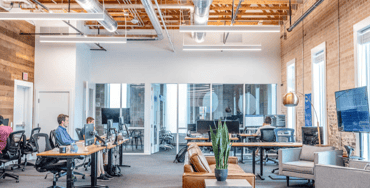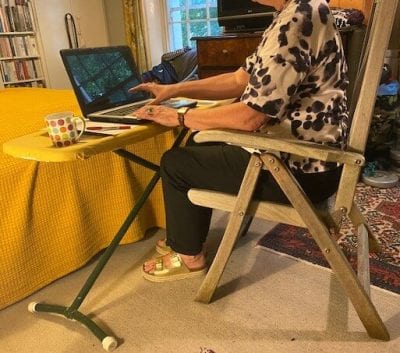
The Government is easing the lockdown. Shops are reopening, the football’s back and pubs, hotels and cinemas will be up and running soon. But this remains an anxious time for everyone, mainly Britain’s 10 million office workers, writes Alec Lom.
The nation’s become hooked on Zoom (the old-fashioned telephone seems to have lost its appeal). And why email someone when you can be nosey and glimpse their home?
Soon though, the great British workforce will return to the office, and the brave new world that awaits – for both employees and employers – will take much getting used to.
Employers will have to consider ditching ‘hot-desking’, which, pre-Covid, had become a popular trend among some sections of the business community. It saves on office furniture and helps cut costs.
But now, the need to prioritise deep-cleaning and wipe-downs after every worker’s shift means that the days of ‘hot-desking’ may be numbered, according to one of the UK’s leading experts who’s now busy advising the corporate sector.

Nichola Adams, a top health ergonomist and back injury prevention expert, also says employees should prepare for ‘the new normal’ of working ‘back-to-back’ rather than face-to-face.
After conducting daily consultations and workstation assessments with individuals throughout lockdown, connecting with them remotely by video, she says awkward makeshift workstations people use, such as ironing boards, are causing them many problems.
Homeworkers risk back pain, migraines, sciatica and RSI by creating workstations from domestic furniture like coffee tables, sofa armrests and rickety garden chairs.
Nichola Adams, who’s conducted hundreds of home workstation assessments since the lockdown began on March 23rd, typically tours top British companies’ offices around the country, advising them on how to minimise the risk of a back injury in the workforce.
Due to the challenges of ensuring a safe workplace, many people she’s consulted fear a second virus wave and predict a return to work in September at the earliest, or even January 2021, so the transition between lockdown and normality will be lengthy.
As a Technical Member of The Chartered Institute of Ergonomics and Human Factors (CIEHF), Nichola has advised more than 3,000 individuals and hundreds of companies over the past 14 years. Her area of expertise, ergonomics – derived from the Greek words’ ergon’, meaning ‘work’, and ‘nomoi’, meaning ‘natural laws’ – is the science of making products and tasks comfortable and efficient for human use (through the application of biomechanics, anthropometrics and psychology).
Also a member of The Association of Chartered Physiotherapists in Occupational Health and Ergonomics, she runs her consultancy Inspired Ergonomics (inspiredergonomics.com), which advises the corporate sector.
Musculoskeletal issues like back pain, injuries, and neck and upper-limb problems cost UK plc nearly 7 million working days annually. At work or home, back pain is indiscriminate and can affect all ages and walks of life at any time. Conducting assessments and providing effective back-pain solutions, Nichola has supported a wide range of individuals, often those affected by stress and long working hours, whether they be FTSE 100 CEOs, small business owners, consultants and office-bound employees, including staff of all shapes and sizes, ranging from a man who was 6ft 8ins tall to a lady returning to work from injury.
Here, she offers employers and employees her 10 Transition Tips on How to Ease Out Of Lockdown:
For Employers:
Tip 1: Consider Ditching ‘Hot-Desking’
When we return to the office, it will be essential to implement a new ‘single-desk-per-day’ regime and clean work surfaces, like desks, chairs, monitors, keyboards and mice, at the end of every individual worker’s shift. So, this does sound like a death knell for the widespread cost-saving practice of ‘hot-desking’. If workers are nervous about continuing to hot-desk, you must respect their concerns.
Tip 2: Downsize to Lower Capacity
Because of the continuing rules on social distancing, companies with, say, 100 staff will now only have the capacity for 20-40 employees in the office at any one time. Businesses should plan for this lower capacity. The need to radically reduce the number of people in the office has prompted many companies to rotate staff daily or by the week to widen the spread between teams. A mix of homeworking and office shifts looks likely for the foreseeable future.
Tip 3: Get Busy Screening & Cleaning
Screens or barriers may be needed around desks. Pods or self-contained units for workers will have partitions on all sides of the desk to stop the virus from spreading when we cough and breathe. Covid-19 lingers longest on plastic, so the more porous your partition fabric, the more the virus is absorbed, meaning there’s less likelihood of transference. Workstations should be cleaned after every shift. Also, chairs, tables, monitors, and office break-out furniture as the virus lands on many surfaces. If used, you should clean the reception sofas after each arriving guest.
Tip 4: Increase Support for Your Workforce
A new Institute for Employment Studies (IES) survey of 500 homeworkers found 75% said their employer had not completed a health and safety risk assessment of their homeworking arrangements in lockdown. People are confused, need help and guidance and want to feel safe. Good advice is scarce. I recommend employers host health and wellbeing workshops, support employees’ mental health, and conduct new office ergonomic workstation assessments, which they’re legally obliged to if workstations move. Some staff may feel keen to return to the office, others nervous. Talk to individuals about their concerns.
Tip 5: Double Employee Allowances
Musculoskeletal issues like back pain, injuries, and neck and upper-limb problems cost UK plc nearly 7 million working days a year. Part of the problem of homeworking is few people have the right equipment to work comfortably in the long term. Many companies offer homeworkers an allowance (average budget from £150) to buy work furniture in a lockdown. But with rough costs, (chair £100-£150), (table £60-£90), (keyboard £40), (mouse £20) adding up to £300, employers should double their allowance. Also, offer advice on what equipment to buy or send their office equipment home.
For Employees:
Tip 1: Beware ‘Makeshift’ Set-Ups at Home
The IES survey found, on average, a 50% increase in back pain issues in lockdown. It’s crucial to seek advice on creating your homeworking set-up correctly, warns Inspired Ergonomics Founder Nichola Adams. “I’ve seen makeshift workstations using ironing boards, drinks cabinets, coffee tables, bar stools, sofa armrests and old fold-up garden chairs and tables. Around 5% of people are reclining on beds. You can get away with it short-term but use tables and office chairs for longer-term homeworking,” advises Nichola. “Adjust furniture to support a healthy posture. If there’s space, stick to tables and office chairs. Simple changes can have a huge impact.”
Tip 2: Think Toilet Seat!
Research on germs by UK ergonomics firm BakkerElkhuizen shows 45,670 more bacteria on an average computer mouse than on the average toilet seat and 20,598 more on a keyboard than on a toilet seat.
When returning to your office, take your keyboard and mouse so any germs are your own. When leaving work, wipe clean to avoid taking office germs home. Positioning equipment incorrectly can cause shoulder and neck strains, headaches, and migraines.
Tip 3: Swap Handbags for Backpacks
Mrs Thatcher famously clobbered politicians with her handbag, but now heavy bags can cause neck and shoulder injuries to women who haven’t been used to carrying them in lockdown. Out-of-condition muscles mean, to avoid injury, it’s wiser to distribute the weight of your belongings evenly using a backpack, preferably with adjustable, padded straps. As many of us may be avoiding public transport, backpacks are ideal when cycling or walking to work.
Tip 4: Watch Your Back
Government guidelines recommend that office workers no longer sit face-to-face at their desks. Instead, employees who are socially distancing correctly are encouraged to sit back-to-back or side-by-side, six feet apart. This may mean desks moving position, so a new ergonomic workstation assessment is recommended.
Tip 5: Make a Stand
With companies reducing their capacity and allowing fewer employees in the office at any one time, workrooms will be less full. Provided you follow social-distancing guidelines, this new environment will enable you to stand up and walk around more often along the guided route. Take regular screen breaks, stand up and move about to help improve blood circulation, ease muscle tension build-up and prevent injury. Do this at home, too.
Adams adds: “Many businesses and employees with whom I’ve consulted now believe they may be returning to work in September or next January.
“There’s the fear of a second wave, and many employers are being very cautious about the health and welfare of their workforce in the office. Some tell me they’re worried you may sue them if an employee falls ill.

“With many of us facing up to another six months at home, there’s now a lot of confusion about what people should be doing, especially as there are still so many unknowns ahead.
“Homeworkers are struggling. One lady in her 20s, who works for a London law firm, used her ironing board as a laptop desk and a rickety fold-up garden chair to sit on.
“The ironing board was too high, giving her severe neck and shoulder problems. The garden chair had a gap at the gap, so without support, she got lower-back pain – all compounded by her moving less than she usually would in the office.
“Others use dining tables that are too high, or their beds, slouching and craning their necks. One lady used her sofa arm as a mouse mat. People think they know how to set up a workstation correctly but need professional support and advice.”
Leading UK osteopath Gavin Burt, whose north London practice Backs & Beyond has just reopened, said patients whose employers had arranged for their office chairs to be transported home reported minor back pain.
“I wasn’t expecting such a high number of patients telling me this,” he said, “but it seems that the small adaptation of having a proper office chair at home, even if only used at the dining table, has helped workers substantially reduce the amount of neck, shoulder, and back pain that they have been suffering from since the beginning of the lockdown.”
*Nichola Adams, MSc Health Ergonomics, Tech CIEHF (Technical Member of The Chartered Institute of Ergonomics and Human Factors), Reg Member ACPOHE (The Association of Chartered Physiotherapists in Occupational Health and Ergonomics), is the Founder of Inspired Ergonomics (inspiredergonomics.com) and one of the UK’s leading back-pain experts, advising companies on how to minimise the risk of back pain in the workplace
Alec Lom is a former Fleet Street and Daily Telegraph journalist
*Alec Lom is a former Fleet Street and Daily Telegraph journalist, now a UK media advisor, whose articles have appeared in a wide variety of newspapers and magazines. He runs his own media and publicity agency supporting companies across the business health & wellbeing sectors www.aleclom.com